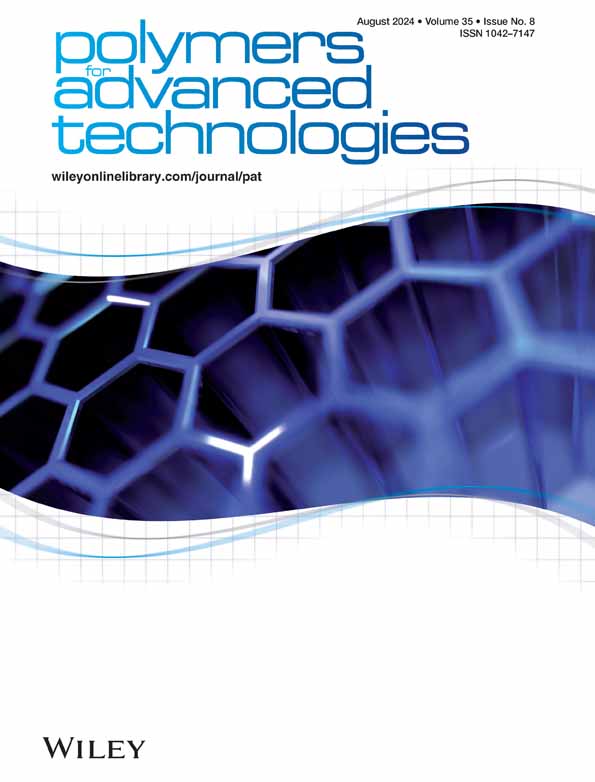Poly(ester amide) from 6‐amino‐1‐hexanol and terephthalic acid: preparation and properties
IF 3.4
4区 工程技术
Q2 POLYMER SCIENCE
引用次数: 0
Abstract
Poly(ester amide)s (PEAs) have received extensive attention due to their unique chemical structure and excellent properties. In this paper, a novel PEA (P6T6T) was prepared through melt polycondensation of terephthalic acid (PTA) and 6T6‐diamide‐diol (6T6), which was from the amidation of 6‐amino‐1‐hexanol and PTA. The structures were characterized by nuclear magnetic resonance, fourier transform infrared, and wide‐angle X‐Ray diffraction, and the thermal properties were evaluated by differential scanning calorimetry and thermal gravimetric analysis for P6T6T. It was found that the melting point of P6T6T was 217°C, which was about 37°C lower than that of PET (254°C), while the initial decomposition temperature was maintained at about 381°C. P6T6T had a fast crystallization rate (the half time of crystallization (6-amino-1-hexanol 和对苯二甲酸的聚酯酰胺:制备和特性
聚酯酰胺(PEA)因其独特的化学结构和优异的性能而受到广泛关注。本文通过对苯二甲酸(PTA)和 6T6 二元醇(6T6)的熔融缩聚反应制备了一种新型 PEA(P6T6T)。通过核磁共振、傅立叶变换红外线和广角 X 射线衍射对其结构进行了表征,并通过差示扫描量热法和热重分析对 P6T6T 的热性质进行了评估。研究发现,P6T6T 的熔点为 217°C,比 PET(254°C)低约 37°C,而初始分解温度保持在约 381°C。P6T6T 具有较快的结晶速度(结晶半时间(t1/2)在 35 至 60 秒之间)和良好的结晶特性。经测量,P6T6T 的饱和吸水率为 2.53 wt%,是 PET(0.83 wt%)的三倍。此外,P6T6T 的水接触角被测定为 57.3°C,远低于 PET(94.7°C)。所有这些结果表明,加入酰胺是提高聚酯纤维吸水性的有效方法。
本文章由计算机程序翻译,如有差异,请以英文原文为准。
求助全文
约1分钟内获得全文
求助全文
来源期刊

Polymers for Advanced Technologies
工程技术-高分子科学
CiteScore
6.20
自引率
5.90%
发文量
337
审稿时长
2.1 months
期刊介绍:
Polymers for Advanced Technologies is published in response to recent significant changes in the patterns of materials research and development. Worldwide attention has been focused on the critical importance of materials in the creation of new devices and systems. It is now recognized that materials are often the limiting factor in bringing a new technical concept to fruition and that polymers are often the materials of choice in these demanding applications. A significant portion of the polymer research ongoing in the world is directly or indirectly related to the solution of complex, interdisciplinary problems whose successful resolution is necessary for achievement of broad system objectives.
Polymers for Advanced Technologies is focused to the interest of scientists and engineers from academia and industry who are participating in these new areas of polymer research and development. It is the intent of this journal to impact the polymer related advanced technologies to meet the challenge of the twenty-first century.
Polymers for Advanced Technologies aims at encouraging innovation, invention, imagination and creativity by providing a broad interdisciplinary platform for the presentation of new research and development concepts, theories and results which reflect the changing image and pace of modern polymer science and technology.
Polymers for Advanced Technologies aims at becoming the central organ of the new multi-disciplinary polymer oriented materials science of the highest scientific standards. It will publish original research papers on finished studies; communications limited to five typewritten pages plus three illustrations, containing experimental details; review articles of up to 40 pages; letters to the editor and book reviews. Review articles will normally be published by invitation. The Editor-in-Chief welcomes suggestions for reviews.
 求助内容:
求助内容: 应助结果提醒方式:
应助结果提醒方式:


